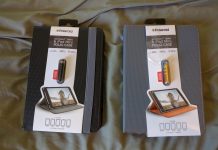 Although E-Ink previously stated it isn’t ramping up color e-ink display production, the rumors of impending color e-ink Kindles simply will not die. Our sister blog Gadgetell reports on a story from rumor-monger Digitimes that claims Amazon is “likely” to launch a capacitive-touch-screened color e-ink Kindle in the second half of this year.
Although E-Ink previously stated it isn’t ramping up color e-ink display production, the rumors of impending color e-ink Kindles simply will not die. Our sister blog Gadgetell reports on a story from rumor-monger Digitimes that claims Amazon is “likely” to launch a capacitive-touch-screened color e-ink Kindle in the second half of this year.
Personally, I can’t see it. I don’t think that color e-ink is mature enough for Amazon to want to step up just yet. Bezos has historically been reluctant to move to any new technology before its time, and over the last couple of years has seemed to be content to let Barnes & Noble take the lead in new e-book platforms. And we haven’t seen B&N moving toward a color e-ink screen yet.
Still, this rumor just keeps making the rounds. I suppose if they keep making that prediction, sooner or later it will turn out to be true.
































There’s no market for color e-Ink.
It won’t have the vibrant colors or the refresh rate of LCD screens so people who care about color and multi-function will still choose a tablet.
It won’t add anything to the experience of reading text. So people who just want a simple device to read books will still choose standard e-Ink.
I have no doubt that Amazon’s next step will be a much improved Fire and a slightly improved Kindle. Probably around Xmas.
I’m hoping for the “much improved Fire” (and maybe a bigger screen?).
There IS a market for color e-ink. I would love to be able to read magazines — with all their full color photos & illustrations — on a screen that doesn’t leave my eyes aching.
Right now I read The Economist on my i-phone and my eyes start to get very tired after about a half an hour of reading (no, it’s not because the screen is too small).
Black and white is fine for reading the average book, but that’s all. Also, a lot of students use Kindles for their text books. That’s fine for most books but the illustrations in a biology, chemistry, or some engineering texts would be almost useless in monochrome.
And not everyone wants a tablet. An e-reader is cheap enough not to worry too much about if you take it with you everywhere (and still readable if you want to read outside) and small enough to carry in a coat pocket. An e-ink reader also doesn’t need to be charged every night either.
So Binko, speak for yourself.
Just because a few random people believe they would like color eInk doesn’t create a market big enough to justify production.
Here’s the problem. My Kindle has a screen resolution of only 800×600. Even if they made a color eInk version it is not even close to having the resolution necessary to display the magazines full of photos and illustrations that you want.
I really doubt that many textbooks are going to display well on a Kindle. It simply can’t display complex pages well at all.
Meanwhile a new IPad has a resolution of 2048×1536. This is more than 6 times as many screen pixels as a Kindle. That’s why things like magazines look so great. People who care about magazines and textbooks are using tablets. The tablet market is booming.
Sorry, but there’s no market for color eInk despite your personal desires. The boom in tablets preempted it. It’s a virtual certainty that Amazon will release a larger improved version of the Fire sometime this year. And it’s also a virtual certainty that they will not be releasing a color eInk Kindle.
Binko I agree fully. Moving to colour starts on a path of escalating demands for colour quality that ultimately will drive people toward the Tablets. For reasons of screen resolution and processing power.
I find Amazon’s strategy puzzling. They probably feel they are only driving people up from their Kindles to their Fire, and so they benefit both sides. However I feel they will be also driving more people toward the iPad because that is where the ultimate colour and magazine experience is, no doubt.
Howard, I agree that Amazon’s strategy is puzzling. But I believe they were caught flat-footed by the success of the iPad and are struggling to catch up.
Few young people these days want to sit down and read for an hour straight, or even fifteen minutes straight. People who simply read are mostly from my generation, in their 40s and 50s.
Young people want to read for a bit, then check their email, then check Facebook, then read a bit more, then do a turn of their group crossword puzzle or other multiplayer game and then watch a video. And they want to do all of this from wherever they happen to be.
I’m sure Amazon will always sell an eInk Kindle. But it won’t be their focus. And it won’t see many improvements. It will end up as a cheap commodity device, perhaps even given away to Prime members. But their real focus will be almost exclusively on the Fire.
Binko – sorry but I depart from you on the young people thing. Young people will read for hours if they find stuff that they WANT to read. The issue is not their short attention span, the issue is producing and finding content that interests them. That is my view and experience only of course. I have seen teenagers become voracious when they find a good title that stimulates them. The publishers often write them off but imho it is a lazy path born out of frustration at producing stimulating product. I have also encountered quite a few kids between 18 and 25 who are already bothered by the constant interruption of email and texts. They appreciate being cut off for period of time.
I personally think that Amazon are making a strategic mistake here IF they are in any way diverting attention to colour and away from basic eReaders. They are being seduced by the sexy tablet market instead of sticking with the mass market reader that beckons as the digital transition gathers pace and that will provide the large core of their customers in the future.
The eInk reader will indeed become a cheaper and cheaper commodity and that is, imho, where it’s power lies in penetrating the market to a depth no tablet can.
I believe amazon should be devoting resources to producing better eInk readers with better processors and better visual experiences (faster blinking and transitions) while pushing down the price and offering readers on plans similar to mobile phones. This would allow masses of readers to access eReaders for <50 dollars and after burn the digital growth. Imho of course.
@Howard – you can add me to the “few random people” demographic. in fact there are a whole lot of these people and they are willing to pay money to read a color magazine on e-paper but they happen to be outside your highly opinionated little bubble. have you checked out the mirasol display from qualcomm or the new e-paper from plastic logic, if not the triton display from e-ink? There is healthy innovation in this space indicating good things to come – and innovation always chases some market.
As the author notes, the technology is not mature yet. but then the display technology of today’s tablets were not developed overnight.
Mr Subbu – Being opinionated is a very welcome compliment. Thank you. I come here to build and express opinions.
While I’m at it, your pointed quote of “few random people” was actually written above by Binko Barnes and not me at all. In the light of that totally inaccurate opening salvo of yours, I can no longer tell if your ‘comment’ is aimed at me or whoever.
Howard, you may well be right when you say that I’m under-estimating today’s youth. That may be a function of the specific young people I see around me on a constant basis. For the most part, they are a shallow and distracted lot.
The other day I started reading a book called “Ship Breaker” by Paolo Bacigalupi, not realizing it was “Young Adult”. The writing style was excellent but eventually something felt a bit “off” to me so I went to check and found that it was indeed YA. Browsing around I was amazed at the massive variety of books written specifically for the youth and young adult market. When I was a boy I would have LOVED to have such a selection of exciting reading material. I was forced to reach into the past for Jules Verne and Edgar Rice Burroughs, which were wonderful, but very limited. However, despite the wondrous variety of available books, I personally see a downtrend in reading among the young in general.
Mr. Subbu, Teleread is one of the few places on the Internet where I post regularly because the level of discourse is fairly high. There’s no need to fling terms like “your highly opinionated little bubble” at people. Of course we have strong opinions but most of here strive to present them reasonably.
If you believe that there is good reason to think that a color eInk device capable of displaying full color magazine sized pages will come to the market any time soon I’d love to here about it.
What I’m seeing are companies like Plastic Logic which are struggling financially and abandoning plans to produce eReaders after years of development because they see no mass market. I grant you that there has been a lot of innovation and research in the color eInk field the last few years. But the ability to turn that into a marketable consumer device has been killed by the massive surge in popularity of tablets and smart-phones.
Binko – I do agree with a lot of what you. However I suggest that there is a potential disconnect between the fact that there is plenty of stuff ‘written for’ young adults … and the attraction that young adults have for those titles.
In my view (for whatever reason) most of the titles being produced just don’t attract those young adults and tend to serve only those who are already big readers.
howard/binko – at any rate, the topic at hand is a matter of fact to me, not of opinion. If the level of dialogue is just opinion not backed up with fact, may be i don’t belong here.
p.s: plastic logic will license out its technology instead of making its own reader. this is a sign of specialization of labor in the value chain. http://www.engadget.com/2012/05/17/plastic-logic-shutters-us-offices-gets-out-of-e-readers/
Subbu wrote:
“the topic at hand is a matter of fact to me, not of opinion. If the level of dialogue is just opinion not backed up with fact, may be i don’t belong here.”
A very good point Subbu.
Above you write: “in fact there are a whole lot of these people and they are willing to pay money to read a color magazine on e-paper but they happen to be outside your highly opinionated little bubble”
I would really appreciate if you could post some links or references to where you learned this ‘fact’ ? Thanks in advance.
Getting back to to the topic, which is specifically one of a ‘rumour’, I also find it curious that you refer to it as a ‘fact’ and not a ‘rumour’.
Subbu, if you so dislike expressions of opinion I would advise you to completely avoid all forums, blogs and message boards. Perhaps a chemistry lab or an observatory would suit you.
Plastic Logic closes offices, losses huge amounts of money and shuts down production of it’s eReader. They are currently in “talks” to license their technology to unnamed companies. You look at these facts and conclude that color eInk devices will be hitting the market soon? Oh my!
alright, lets have a chat.
we need to separate two concepts here : e-ink vs. LCD and ereader vs. tablet. they are two very different debates. but the nature of technologies are such that e-ink works best for reading and LCDs for tablets. its pointless to have a 60hz refresh rate for reading. the debate here is the former – e-ink vs LCD.
in fact, we can generalize e-ink displays to simply e-paper – displays that are designed to be a pure substitute to paper and aren’t back-lit.
talk to a graduate student who reads academic literature in pdf form for long hours – he/she will swear by e-ink. the device gets out of the way and lets you connect with the content directly. (i personally own a rooted kindle dx and a nook simple touch)
The lack of color in e-ink has limited the device’s capability in terms of the reading material that can be consumed on it – and by extension what is produced for it. there is a market for color e-paper technology that isn’t backlit and easy on the eye. people realize that. there are several technologies in this race. the best one will win.
@howard – i cant count the number of people in this market obviously. if you go by the symptoms, the fact that qualcomm has committed $2b to its IMOD display should tell you something (the $1b factory in taiwan comes live later this year) they know hat they’re doing. look it up.
@binko: you can’t dismiss people expressing their opinion as “few random people”. trying to be loud will only invite heckling. like the commenter above said: speak for yourself. i’m off to my chemistry lab.
Like gregnsf says, Binko, speak for yourself.
The Amazon Kindle already has touch-screen e-ink with 3G/wifi connectivity. The moment they upgrade that to colour e-ink (and support the ePub file format) is the moment I hand over my money to them.